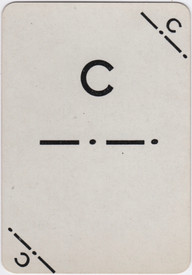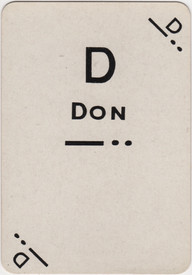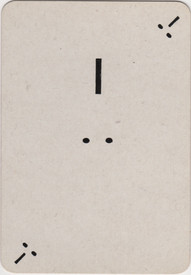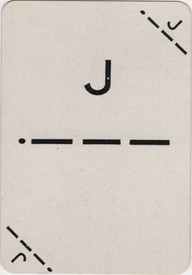Iddy Umpty
- Peter Berthoud
- Dec 8, 2022
- 8 min read
Updated: Jan 24
The New Wireless Card Game - Quickly teaches you to read Morse
Published by Thomas de la Rue & Co. Ltd. London 1922
This antique game with its onamatopoeic name requires each player to have a pack of unusual cards. Aside from the all-seeing Joker, the cards each bear one letter from the Morse Code alphabet, but a few cards, apparently at random, are also assigned a word.
If found at a boot fair or a junk shop it would be easy to dismiss a box of these monochrome cards as an incomprehensible and probably tiresome word game but I liked the box and wanted to find out more.

Iddy Umpty Box
The telegraphic code that Samuel Morse had a hand in developing was first used in 1844 and later refined. Letters of the alphabet, numbers and a few special characters are rendered as combinations of dots and dashes according to the frequency of their use in English. For example, 'E' being the letter most commonly used in English, is rendered as the shortest coded letter, a single dot.
Originally telegraphic receivers made appropriate marks on a paper tape and an operator could then read the series of marks to decipher the message. Soon, operators could recognise letters by the different sounds being made by the receiver and no longer needed to look at the tape. By the 1890s Morse was being used to communicate via radio and the sounds of the tones for dots and dashes became known as "iddys" and "umptys" and "Iddy Umpty" became slang for an Army Signaller.
The earliest print mention of "Iddy Umpty" I can find dates to 1891. The Civil and Military Gazette reported that on May 28th in Kasauli, Northern India, there had been a presentation of a bracelet "to the ladies in the tennis mixed doubles by the iddy-umpties, or budding inspectors of army signalling."
The London Gazette, 4th March 1915 credits Captain W.G. Craigen of Aberdeen of the Highland Brigade, then stationed in the Northern Territorial Province, India, for inventing "a system for facilitating the study of Mose-code of signalling under the title of 'Umpty Iddy". A year earlier, the then Lieutenant W.G.Craighen had written to the Editor of The Aberdeen Evening Expresss to robustly assert his invention against doubts raised by a person known only as "Iddy Iddy Umpty".
Sir,—My attention has been drawn a letter which appeared in your issue 12th inst., signed "Iddy Iddy Umpty". I certainly do claim originality for my system. The method of memorising the Morse Code to which your I correspondent refers is probably that included in the Army Signalling Manual, 1896, the existence of which was quite unknown me until after the publication of my own system. There is absolutely no similarity in theory or form between the rather complicated "diagrams" given in the manual and my "system letters" although both methods endeavour to depict the Morse alphabet in a way that the letters may be retained in the "mind's eye". I am inclined to think that your correspondent wrote his letter after reading your review and without seeing my system letters or pausing to compare them with a fourteen-year-old recollection. In any event, he could not possibly have seen "the same system of writing" at the date he mentions. I enclose a copy of my booklet, and shall be obliged if you will forward to him. This reply is written by permission of my commanding officer, and I am, course, debarred from entering into any further correspondence on the subject.
I may perhaps be pardoned for adding that your correspondent would only have been acting with fairness had he taken the trouble to verify his statement before publicly accusing of "picking another man's brains."—I am, etc.,
W. G. Craigen (Lieut)., (T.)
Woolwich, 14th April, 1915.
By the end of World War I a new word based on 'Umpty' had been coined: "umpteen". The umpty dash of Morse being coopted to represent any indeterminate, but probably large, number, e.g. "That's the umpteenth Bosche that I've killed today." E.A.Mackintosh, War the Liberator, 1918 cited in the OED.
A pack of Iddy Umpty cards
In the game the words ACK, BEER, DON, EMMA, PIP, ESSES, TOC & VIC were added to certain letters. To avoid any confusion letters that could potentially sound similar were given these distinctive words by the British Army and were specified in the Signalling Regulations of 1904 and 1914. British Naval and Airforce codes used the same principle but many different words. At the bottom of this post are the World War II Allied and 1959 NATO alphabets, only V=VICTOR retains a trace of its origins.
In 1915 Army Chaplin "Tubby" Clayton established a soldier's rest house in Belgium for troops heading to or from the front lines. The house was called Talbot House and abbreviated to "T.H." thus it became known as "TOC-H" by soldiers familiar with the daily use of this code alphabet. Following the war Toc H became a UK based charity and is still at work today, you can read more about them here.
When Iddy Umpty was published in 1920 there was a well established popular civilian enthusiasm for learning Morse Code.
In 1906 The Daily Mail relayed the General Election results of 1906 by Morse, employing searchlights to flash signals into the night sky over Central London. The Aberdeen Journal January 13th 1906 reported that the Mail had "been coaching its readers in how to read Morse Code ... this newspaper believes that it better to repeat 'umpty' for dashes" and 'iddy' for the dots.".
Home-made receivers were popular with the sort of people you can imagine being interested in them. Pearson's Weekly devoted the best part of a page in 1912 to a gentleman who had built his own set with jam jars, the "longest bamboo pole" he could find, some insulated copper wire, a cardboard tube, a broom-stick, an old telephone and his mother's work-box for a total cost of less than ten shillings!
Almost as soon as this gentleman had connected his apparatus to the water tap in his kitchen he began hearing messages. The first message was in French, which must have been disappointing but soon after he was picking up reassuringly English Admiralty instructions in codes that he couldn't understand. The unnamed gent said "I tell you I felt proud of my little home-made installation ... I have received some hundreds of messages ... Only the other day I intercepted a call from a vessel somewhere out at sea off the North Foreland. I have received others from as far away as Grimsby, on the north, and Bristol, on the south.". I imagine this anonymous amateur radio builder (and listener) would have regarded the house illustrated on the box of Iddy Umpty as being the home of his dreams.
Junior enthusiasts were first catered for in 1914 when a pre-made signalling set for two children was invented by Captain Gonne, it was predictably called 'Iddy Umpty', and sold for 1s/6d.

Iddy Umpty 1922 Magazine Illustration.
Iddy Umpty the card game was published in 1922. A contemporary review said:
"Under this somewhat ungainly title will be found a very excellent new card game, published by Thomas de la Rue and Co., which has exceptional merits, for it will make children familiar in a very easy fashion with the Morse code...The game is published in attractive boxes at 2s/6d and 4s/6d each."
I think the accompanying illustration is of the four pack 4s/6d set. I have the two pack version. As a full pack was needed by every player this could have been a substantial investment for a large family!
The British Newspaper Archive has been invaluable in uncovering the newspaper articles referred to.
Rules
Iddy Umpty Rules
Any number may play.
The game is played with packs of cards, each set containing a complete set of Morse Code Alphabets and the Joker.
One pack of cards should be provided for each person playing.
The cards being shuffled, are dealt on at a time face downwards to each player until the cards are exhausted.
Each player must arrange his cards in a pile in front of himself keeping them face downwards.
The player to the dealer’s left then turns the top card of his pile towards the players and places it face upwards on the table, the next player the the left does the same and the rest follow in rotation.
Each card as turned up must be placed on top of the card he previously turned.
When a card is turned up similar to one exposed, either of the two players owning these cards may call “Iddy” for each — and “Umpty” for each — together with the letter being represented. For example:- Should two R’s turn up, the player will say “Iddy Umpty Iddy R.” In the case of those letters which, owing to their sound being very like another letter, have special names, the name of the letter must be called. For example: the letter A would be “Iddy Umpty Ack.”
The player first calling out the correct sound wins the trick and takes the whole of the other players turned cards and places them face downwards at the bottom of his exposed cards.
The winner of the trick shall play the next card.
The Joker shall represent any letter.
Any player calling when no card is exposed similar to the one turned up, has to place his pile of turned cards (with the last exposed card at the top) in the centre of the table as a pool, and the pool may consist of any number of separate piles contributed in this way. Play then proceeds as before.
When a card is turned up similar to one exposed in the pool, any player may call in the usual manner the dots and dashes with the letter and in addition ”Pool” and the first one calling correctly takes the whole of that pile from the Pool and the pile with the corresponding card exposed in front of another player. The call would be “Iddy Umpty Ack Pool.” or according to the letter represented by the cards exposed.
When the Joker is played the winner of the trick takes all the cards exposed in front of the players. The player exposing the Joker may call to any exposed card, whilst any other player only calls the card on his own pile.
After a player has exposed the whole of his stock of cards he turns them over and plays them again.
The game is won by the player who succeeds in taking the whole of the cards.
The allied military alphabet changed during World War II to encompass every letter and become a single code:
A = ABLE, B = BAKER, C = CHARLIE, D = DOG, E = EASY, F = FOX, G = GEORGE, H = HOW, I = ITEM, J = JIG, K = KING, L = LOVE, M = MIKE, N = NAN, O = OBOE, P = PETER, Q = QUEEN, R = ROGER, S = SUGAR, T = TARE, U = UNCLE, V - VICTOR, W = WHISKEY, X =X-RAY, Y = YOKE, Z = ZEBRA
In 1959 the "NATO" alphabet became the new standard:
A = ALFA, B = BRAVO, C = CHARLIE, D = DELTA, E = ECHO, F = FOXTROT, G = GOLF, H = HOTEL, I = INDIA, J = JULIET, K = KILO, L = LIMA, M = MIKE, N = NOVEMBER, O = OSCAR, P = PAPA, Q = QUEBEC, R = ROMEO, S = SIERRA, T = TANGO, U = UNIFORM, V - VICTOR, W = WHISKEY, X = X-RAY, Y =YANKEE, Z = ZULU




























































